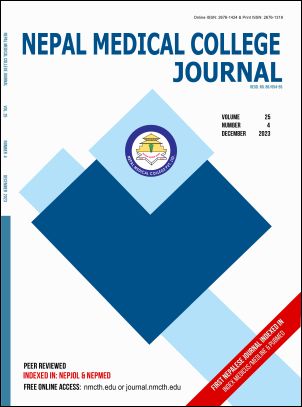Comorbid Diabetes and Hypertension: Gender differences in prevalence and risk factors among adults (≥18 years) in an urban community in Kathmandu District in Nepal
DOI:
https://doi.org/10.3126/nmcj.v25i4.60872Keywords:
Comorbid diabetes and hypertension, gender, prevalence, risk factors, NepalAbstract
Chronic diseases such as diabetes and hypertension are often influenced by biological, behavioural, environmental and social factors in women and men. This study aimed to identify the gender differences in prevalence and risk factors of comorbid diabetes and hypertension (CM) among adults aged 18 years and above in an urban community in Kathmandu, Nepal. A community-based cross-sectional analytical study was carried out in Gokarneshwor Ward 1, 2 and 3 among adults aged 18 years and above from September 2020- May 2023. Diabetes (DM) was defined as persons previously diagnosed by a physician and/or on anti-diabetic medication. Hypertension (HTN) was defined as a systolic blood pressure (SBP) of ≥140 mm Hg or a diastolic blood pressure (DBP) of ≥90 mm Hg or those who were diagnosed by a physician and/or receiving antihypertensive medication. Comorbidity (CM) was defined as persons with diabetes and hypertension. Information regarding socio-demographic data, behavioural and biological risk factors, anthropometric assessment and morbidity were obtained from adults aged 18 years and above using a Family study proforma. Multinomial logistic regression analyses with the referent category being persons with no diabetes or hypertension (NDH) were performed for three categories HTN vs NDH, DM vs NDH and CM vs NDH. Among 1538 adults with 776 women, overall prevalence of comorbidity was 5.3% (95% CI: 4.3 – 6.5); among men 6.1% and 5.5% among women. After adjusting for age, for both women and men, being currently married, alcohol use, family history of diabetes and generalized obesity were associated with comorbidity. However, these associations were more robust for men. Moreover, measures of central obesity were associated with comorbidity for men alone. Though alcohol use was higher among men, the association with comorbidity was more robust for women. Paradoxically, lower educational status among women and higher education among men were associated with higher odds of comorbidity. In conclusion, prevalence of comorbid diabetes and hypertension may differ marginally among men and women. Though comorbidity rates appear to be lower in Nepal in comparison to other countries in South Asia, the rising burden emphasizes the need for tailored public health interventions that address modifiable risk factors among men and women. Further research may help to elucidate the role of gender on cardiovascular risk and hard outcomes such as cardiovascular events and mortality among persons with comorbid diabetes and hypertension.
Downloads
Downloads
Published
How to Cite
Issue
Section
License
Copyright (c) 2023 Nepal Medical College Journal

This work is licensed under a Creative Commons Attribution 4.0 International License.
This license enables reusers to distribute, remix, adapt, and build upon the material in any medium or format, so long as attribution is given to the creator. The license allows for commercial use.




